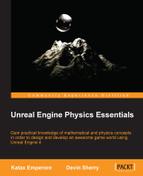In this chapter, we discussed a handful of mathematical and physics-based concepts that are necessary to grasp in order to understand how physics works in Unreal Engine 4. We looked at the different units of measurement that exist in the American and European standards of length and how they convert from one to another. We also looked at Unreal Units (uu). Then, we discussed the common measurements for walls, doorways, characters, and stairs.
Next, you learned a little bit about scientific notation, how it works, and how it is used. We looked at some basic and advanced examples of conversions from numerical to scientific notations.
Additionally, you learned about the 2D and 3D coordinate systems and how they are used in the real world and in Unreal Engine 4. We also investigated the different 2D and 3D viewports that exist in Unreal Engine 4 and the important functions they serve when you create game worlds.
Furthermore, you learned about the scalar and vector properties and how they are applied in the real world and in Unreal Engine 4. We also looked at examples of how the values of scalars and vectors are used in the Material editor and in blueprints.
We also looked at each of the three Newtonian laws of motion and provided real-world and Unreal Engine 4 examples for each law.
Lastly, you learned about the different forces and energy that exist in the real-world and provided examples on how to apply forces in blueprints.
Now that we have a base understanding of real-world mathematics and physics concepts and how they are used in Unreal Engine 4, we can now move on to the Physics Asset Tool (PhAT) in Unreal Engine 4.
